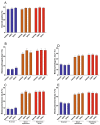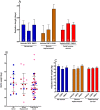Actions of CSF2 and DKK1 on bovine embryo development and pregnancy outcomes are affected by composition of embryo culture medium
- PMID: 35525843
- PMCID: PMC9079070
- DOI: 10.1038/s41598-022-11447-7
Actions of CSF2 and DKK1 on bovine embryo development and pregnancy outcomes are affected by composition of embryo culture medium
Abstract
Procedures for in vitro embryo production in cattle have not been optimized. In the current experiment, we utilized a 3 × 3 factorial design to test whether the proportion of embryos becoming blastocysts in culture and the pregnancy rate after embryo transfer are affected by type of serum in the medium [no serum; 3% (v/v) KnockOut Serum Replacement (SR); 3% (v/v) fetal bovine serum (FBS)] and addition of specific embryokines [vehicle; 10 ng/mL colony stimulating factor 2 (CSF2); 100 ng/mL dickkopf related protein 1 (DKK1)] at day 5 of culture. Embryos were produced using abattoir-derived ovaries and Y-sorted semen from two Angus sires. The percent of putative zygotes and cleaved embryos becoming blastocysts was improved by SR and FBS. Pregnancy rate at day 30 was determined for 1426 Nelore recipients and calving rate for 266 recipients. In the absence of CSF2 or DKK1, pregnancy rates were lower for embryos cultured with SR or FBS. CSF2 and DKK1 reduced pregnancy rate for embryos cultured without serum but had no detrimental effect in the SR or FBS groups. Indeed, CSF2 blocked the negative effect of FBS on pregnancy rate. Data on birth weights were available for 67 bull calves. There were no effects of treatment. The sire used to produce embryos had significant and large effects on development to the blastocyst stage, pregnancy rate at day 30, calving rate and pregnancy loss between day 30 and calving. Results indicate that (1) SR and FBS can improve embryonic development in vitro while also compromising competence of embryos to survive after transfer, (2) actions of CSF2 and DKK1 depend upon other characteristics of the embryo production system, and (3) sire can have a large effect on embryonic development before and after transfer.
© 2022. The Author(s).
Conflict of interest statement
The authors declare no competing interests.
Figures


Similar articles
-
Consequences of exposure of embryos produced in vitro in a serum-containing medium to dickkopf-related protein 1 and colony stimulating factor 2 on blastocyst yield, pregnancy rate, and birth weight.J Anim Sci. 2017 Oct;95(10):4407-4412. doi: 10.2527/jas2017.1927. J Anim Sci. 2017. PMID: 29108044
-
Effect of Dickkopf-1 and colony stimulating factor-2 on the developmental competence, quality, gene expression and live birth rate of buffalo (Bubalus bubalis) embryos produced by hand-made cloning.Theriogenology. 2020 Nov;157:254-262. doi: 10.1016/j.theriogenology.2020.07.022. Epub 2020 Aug 1. Theriogenology. 2020. PMID: 32823021
-
In vitro production of bovine embryos in medium supplemented with a serum replacer: effects on blastocyst development, cryotolerance and survival to term.Theriogenology. 2007 Dec;68(9):1316-25. doi: 10.1016/j.theriogenology.2007.08.034. Epub 2007 Oct 10. Theriogenology. 2007. PMID: 17931700
-
Bioactive supplements influencing bovine in vitro embryo development.J Anim Sci. 2022 Jul 1;100(7):skac091. doi: 10.1093/jas/skac091. J Anim Sci. 2022. PMID: 35772761 Free PMC article. Review.
-
Effects of gamete source and culture conditions on the competence of in vitro-produced embryos for post-transfer survival in cattle.Reprod Fertil Dev. 2010;22(1):59-66. doi: 10.1071/RD09212. Reprod Fertil Dev. 2010. PMID: 20003846 Review.
Cited by
-
Reduction of nutrients concentration in culture medium has no effect on bovine embryo production, pregnancy and birth rates.Sci Rep. 2025 Feb 9;15(1):4839. doi: 10.1038/s41598-025-88864-x. Sci Rep. 2025. PMID: 39924566 Free PMC article.
-
Review: Some challenges and unrealized opportunities toward widespread use of the in vitro-produced embryo in cattle production.Animal. 2023 May;17 Suppl 1(Suppl 1):100745. doi: 10.1016/j.animal.2023.100745. Animal. 2023. PMID: 37567654 Free PMC article. Review.
-
In vitro maturation of Nelore breed (Bos taurus indicus) oocytes using either purified porcine FSH or recombinant human FSH: results from a large-scale in vitro embryo production routine.Front Vet Sci. 2025 Jul 14;12:1596006. doi: 10.3389/fvets.2025.1596006. eCollection 2025. Front Vet Sci. 2025. PMID: 40727270 Free PMC article.
-
Disruption of CSF2RA in the bovine preimplantation embryo reduces development and affects embryonic gene expression in utero.Reprod Fertil. 2023 Mar 1;4(2):e230001. doi: 10.1530/RAF-23-0001. Online ahead of print. Reprod Fertil. 2023. PMID: 37000631 Free PMC article.
-
Bovine embryo production in vitro: evolution of culture media and commercial perspectives.Anim Reprod. 2024 Sep 23;21(3):e20240051. doi: 10.1590/1984-3143-AR2024-0051. eCollection 2024. Anim Reprod. 2024. PMID: 39372256 Free PMC article. Review.
References
-
- Viana J. Statistics of embryo production and transfer in domestic farm animals. Embryo Technol. Newsl. 2020;38(4):7–26.
-
- Pontes JHF, Nonato-Junior I, Sanches BV, Ereno-Junior JC, Uvo S, Barreiros TRR, Oliveira JA, Hasler JF, Seneda MM. Comparison of embryo yield and pregnancy rate between in vivo and in vitro methods in the same Nelore (Bos indicus) donor cows. Theriogenology. 2009;71:690–697. doi: 10.1016/j.theriogenology.2008.09.031. - DOI - PubMed
Publication types
MeSH terms
Substances
Grants and funding
LinkOut - more resources
Full Text Sources
Research Materials

